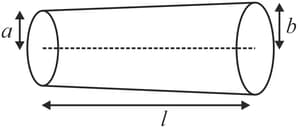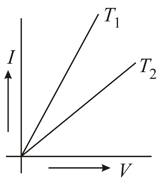The figure shows a conductor of length having a circular cross-section.

The radius of cross-section varies linearly from to . The resistivity of the material is . Assuming that , find the resistance of the conductor.


Important Questions on Electric Current and Circuits
(iii) current density in the function of radial distance
(iv) electric field in the function of radial distance
(a) A steady current flows in a metallic conductor of the non-uniform cross-section. State which of the quantities, i.e., current, current density, electric field, and drift velocity remain constant?
(b) A steady current passes through a cylindrical conductor. Is there an electric field inside the conductor?
A potential difference is applied to copper wire of diameter and length What will be the effect on the electron drift speed, by doubling:
(a) voltage ,
(b) length and
(c) diameter
The following table gives the length of three copper rods, their diameters and the potential differences between their ends. Rank the rods according to (a) the magnitude of the electric field within them, (b) the drift speed of electrons through them and (c) the current within them, greatest first.
| Rod | Length | Diameter | P.D. |
| 1 | |||
| 2 | |||
| 3 |
The graph for a metallic wire at two different temperatures and is shown in the figure. Which of the two temperatures and is higher and why?

